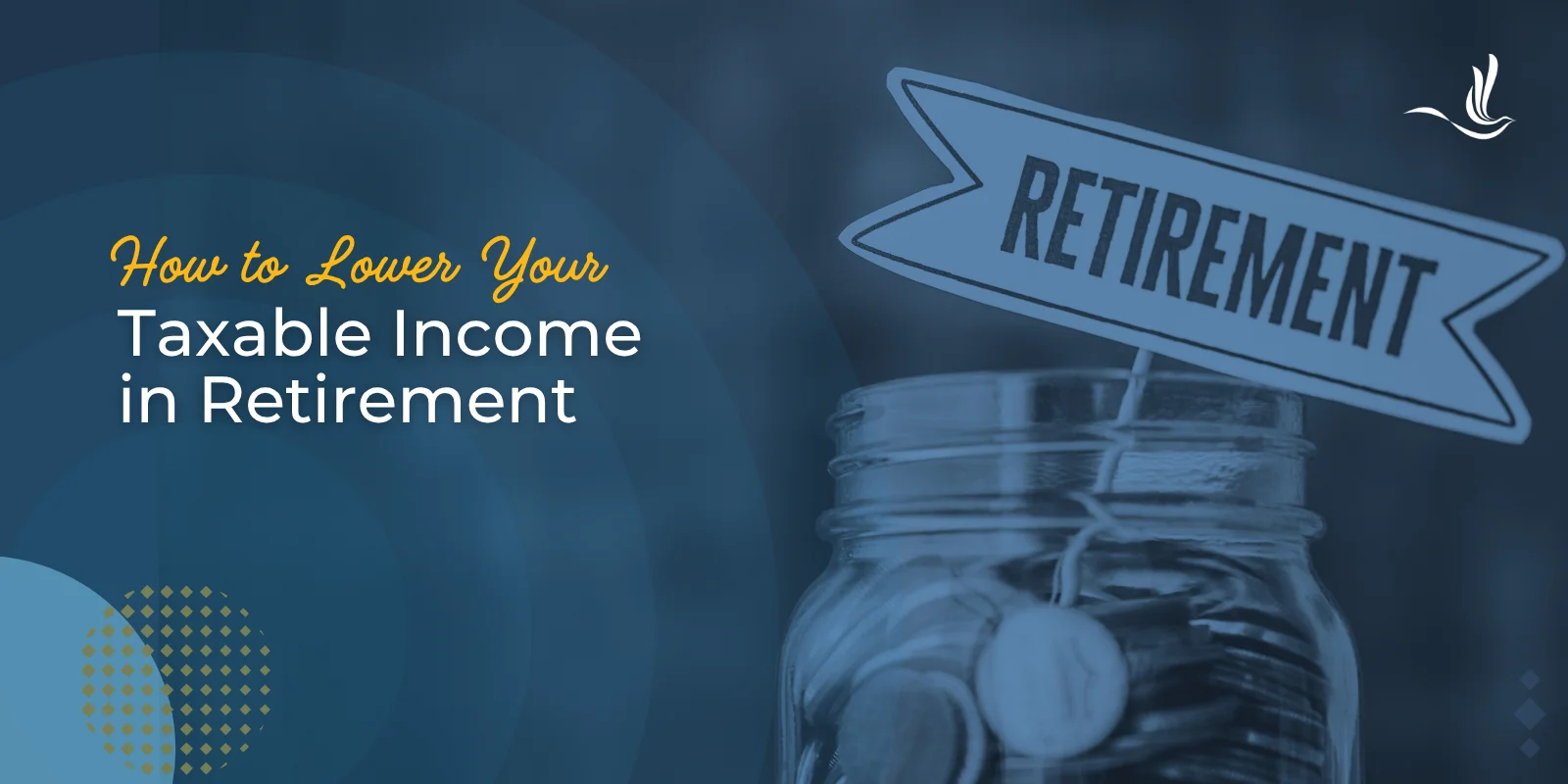Key Takeaways:
- Smart withdrawal sequencing, from taxable, tax-deferred, and Roth accounts, helps control your annual tax bracket and reduce lifetime taxes.
- Use “tax gap” years before RMDs and Social Security to complete Roth conversions or realize gains at lower rates.
- Manage Required Minimum Distributions (RMDs) early and consider Qualified Charitable Distributions (QCDs) to lower adjusted gross income.
- Leverage Roth IRAs for tax-free withdrawals and future flexibility without affecting Medicare premiums or Social Security taxation.
- Apply tax-efficient investing: place income-producing assets in tax-deferred accounts and high-growth assets in Roth or taxable accounts.
- Work with a tax advisor to customize strategies, such as QLACs, gifting, and state tax planning, to minimize long-term taxable income in retirement.
For many retirees, tax planning doesn’t end when the paychecks stop; it becomes even more critical. Even if you’ve saved diligently, how and when you withdraw money from your retirement accounts can significantly impact how much you owe the IRS. Understanding how to lower your taxable income in retirement can help stretch your savings, preserve wealth, and keep your retirement lifestyle comfortable.
Taxes in retirement are complex because income may come from several sources, like Social Security, pensions, IRAs, annuities, and investments, each with unique tax rules. Fortunately, there are strategies to minimize your tax burden legally and efficiently.
Below, we’ll explore IRS-compliant ways to lower taxable income in retirement, including withdrawal sequencing, Roth conversions, charitable giving, and tax-efficient investment placement.
Understanding What Counts as Taxable Retirement Income
Before exploring how to reduce taxable income, it’s important to understand what qualifies as taxable in the first place. Not all retirement income is treated equally.
Common Sources of Taxable Income
- Traditional IRA and 401(k) withdrawals — These accounts are funded with pre-tax dollars. Every dollar you withdraw is taxed as ordinary income.
- Pension and annuity payments — Most pension income and annuity distributions are fully taxable at your regular income tax rate.
- Social Security benefits — Depending on your overall income, up to 85% of your Social Security benefits can be taxable.
- Investment income — Interest, dividends, and capital gains from taxable brokerage accounts may also add to your taxable income.
- Part-time work or consulting — Any earned income is subject to federal and, in most cases, state income tax.
Understanding Combined Income and Social Security Taxation
The IRS calculates how much of your Social Security is taxable based on your combined income, which includes adjusted gross income (AGI) + nontaxable interest + half your Social Security benefits.
- If your combined income is below $25,000 ($32,000 for joint filers), your Social Security isn’t taxed.
- Between $25,000–$34,000 ($32,000–$44,000 for joint filers), up to 50% may be taxable.
- Above those thresholds, up to 85% becomes taxable.
Because withdrawals from tax-deferred accounts raise your AGI, they can indirectly increase how much of your Social Security is taxed. That’s why managing your income sources strategically matters.
Use a Smart Withdrawal Strategy
Choosing which accounts to withdraw from and when is one of the most effective ways to reduce taxable income in retirement. The sequence of withdrawals, known as “withdrawal order”, can determine how long your savings last and how much you pay in taxes over time.
The Proportional Withdrawals Approach
One common method involves taking proportional withdrawals each year from your taxable, tax-deferred, and Roth accounts.
Advantages:
- Keeps your tax brackets stable year-to-year.
- Reduces the risk of running one account dry too soon.
Drawbacks:
- Doesn’t necessarily minimize total taxes over your lifetime.
- May trigger higher taxation on Social Security or Medicare premiums if not carefully balanced.
Tax Bracket Management and Timing
Another, often more efficient, strategy is to deliberately manage withdrawals to “fill up” lower tax brackets before triggering higher ones.
Let’s look at an example. Suppose a married couple retires at 65 with $40,000 of annual Social Security benefits and $100,000 in a traditional IRA. They could strategically withdraw enough from the IRA to reach, but not exceed, the 12% tax bracket each year. The remainder of their income could then come from a Roth IRA or taxable investments.
This technique helps avoid pushing income into higher brackets and avoids increasing Medicare Part B and D premiums under the IRMAA (Income-Related Monthly Adjustment Amount). Because IRMAA surcharges are based on your modified adjusted gross income (MAGI), even moderate increases from withdrawals can significantly raise monthly premiums for you and your spouse.
Taking Advantage of the “Tax Gap” Years
Many retirees have a window of lower taxable income between retirement and the start of Social Security or required minimum distributions (RMDs) at age 73. These years present an ideal opportunity to:
- Execute Roth conversions while in a lower bracket.
- Realize capital gains at favorable long-term rates.
- Withdraw from tax-deferred accounts early to reduce future RMDs.
This period, often called the “tax planning sweet spot”, can save thousands over the course of retirement. For those who delay Social Security until age 70, this period of lower income can be extended, creating an ideal ‘tax gap’ for Roth conversions or realizing capital gains at favorable rates.
Plan Ahead for Required Minimum Distributions (RMDs)
Required Minimum Distributions (RMDs) are one of the most common causes of higher taxable income in retirement.
Understanding RMD Rules
Once you reach age 73 (for those who turned 72 after 2022), the IRS requires annual withdrawals from traditional IRAs, 401(k)s, and similar tax-deferred accounts. These distributions are fully taxable as ordinary income. Failure to take RMDs results in steep penalties, 25% of the amount that should have been withdrawn (reduced to 10% if corrected quickly).
Unlike IRAs, 401(k) RMDs can sometimes be postponed if you continue working past age 73 and don’t own more than 5% of the company. This delay provides extra flexibility to manage taxable income during your early retirement years, giving you more control over withdrawals, tax brackets, and potential Roth conversions.
Strategies to Manage RMDs
- Take smaller withdrawals before age 73. Start gradually drawing down tax-deferred accounts in your 60s to reduce future RMD sizes.
- Convert to Roth IRAs. Since Roth IRAs aren’t subject to RMDs during your lifetime, conversions can minimize taxable income later.
- Make Qualified Charitable Distributions (QCDs). Retirees aged 70½ or older can donate up to $108,000 annually directly from an IRA to a qualified charity. This counts toward RMD requirements but isn’t included in taxable income.
For example, if your RMD is $20,000 but you donate $10,000 via a QCD, only $10,000 remains taxable. This effectively lowers your AGI and possibly your Medicare premium bracket.
Use Roth Accounts Strategically
Roth accounts, Roth IRAs and Roth 401(k)s, are invaluable tools for tax diversification. Their unique treatment allows tax-free withdrawals in retirement if conditions are met.
Tax-Free Withdrawals from Roth Accounts
Withdrawals from a qualified Roth IRA are entirely tax-free, provided the account is at least five years old and you’re over 59½. Because these withdrawals don’t increase your adjusted gross income, they don’t affect the taxation of Social Security benefits or Medicare premium thresholds.
For example, if you need an extra $15,000 for a vacation, withdrawing it from a Roth IRA (if you are over 59½ years old and your account is at least 5 years old) rather than a traditional IRA keeps your AGI, and your overall tax liability, unchanged.
Continuing Contributions and Backdoor Roth Options
If you still have earned income in retirement (from part-time work or consulting), you can continue contributing to a Roth IRA or 401(k), subject to income limits.
Higher-income retirees can consider a backdoor Roth IRA conversion, which involves contributing to a traditional IRA and then converting those funds to a Roth. Though taxes apply at conversion, future growth and withdrawals are tax-free, providing long-term flexibility.
Take Advantage of Tax-Free Giving
Charitable giving can be a powerful tax-reduction tool for retirees—especially when coordinated with RMDs and appreciated investments.
Qualified Charitable Distributions (QCDs)
As noted earlier, QCDs allow retirees aged 70½ or older to donate directly from an IRA to a qualified charity. The donated amount is excluded from taxable income and counts toward RMD obligations. This strategy is particularly valuable because it bypasses itemized deduction limits, benefiting even those who take the standard deduction.
For instance, a retiree donates $20,000 directly from an IRA to a local food bank. The full amount reduces taxable income by $20,000, even though they don’t itemize.
Family Gifting Strategies
Beyond charity, retirees can reduce taxable income by gifting appreciated assets or cash to family members. The annual gift tax exclusion allows gifts of up to $19,000 per recipient (in 2025) without incurring gift tax. Gifting appreciated assets to children or grandchildren in lower tax brackets can also reduce future capital gains exposure for the giver.
Optimize Income Location and Diversification
Not all investment accounts are taxed equally. The “location” of your assets, the type of account they’re held in, affects how much you pay in taxes on dividends, interest, and growth.
The Importance of Asset Location
Tax-efficient investing places income-producing assets (like bonds or REITs) inside tax-deferred accounts and growth-oriented assets (like stocks) in taxable or Roth accounts.
- Tax-deferred accounts (traditional IRA, 401(k)): Best for bonds or high-yield assets, since their interest would otherwise be taxed annually.
- Taxable brokerage accounts: Ideal for assets taxed at lower capital gains rates, like long-term stock holdings.
- Roth accounts: Suitable for high-growth assets, since gains will be tax-free at withdrawal.
Proper asset placement helps manage both current taxes and future RMDs.
Diversifying Retirement Income Sources
Having a balance of taxable, tax-deferred, and tax-free accounts gives retirees flexibility to manage income each year. This approach, known as tax diversification, allows you to adjust withdrawals strategically, drawing from different buckets based on your annual tax situation.
For example, if a year’s expenses push you close to the top of your tax bracket, supplementing from a Roth account rather than your IRA can prevent crossing into a higher tax tier.
Explore Less-Known Tax Reduction Tools
Beyond common strategies like Roth conversions and QCDs, retirees can consider advanced planning tools that further manage taxable income.
Qualified Longevity Annuity Contract (QLAC)
A Qualified Longevity Annuity Contract is a deferred annuity purchased with funds from a traditional IRA or 401(k). It allows retirees to postpone RMDs on up to $210,000 of their qualified assets (as of 2025).
Benefits:
- Reduces taxable income during the early years of retirement.
- Provides guaranteed income starting later, often at age 80 or 85, helping hedge against longevity risk.
By delaying distributions, QLACs help smooth income levels and prevent large spikes in taxable income later in life.
Tax-Deferred Annuities
Another approach is investing in a non-qualified, tax-deferred annuity. While earnings are taxed upon withdrawal, the growth accumulates tax-free until then. This can be beneficial if you expect to be in a lower bracket later or want to delay income recognition for several years.
Health Savings Accounts (HSAs)
HSAs also offer significant tax flexibility in retirement. Funds can be used tax-free for qualified medical expenses, and after age 65, withdrawals for non-medical expenses are treated like a traditional IRA, or taxable as ordinary income. This provides another tool for managing taxable income while covering healthcare or other retirement expenses.
Manage Investment Gains and Losses
Investment management doesn’t stop at retirement; it simply shifts focus from accumulation to preservation and tax efficiency.
Tax-Loss Harvesting
If you hold investments in a taxable brokerage account, you can use tax-loss harvesting to offset gains. Selling underperforming assets at a loss allows you to offset capital gains dollar-for-dollar.
- Up to $3,000 of net losses can also offset ordinary income each year.
- Unused losses can be carried forward indefinitely.
Let’s look at an example. If you realize a $5,000 capital gain on one investment but sell another at a $5,000 loss, your net capital gain is zero; potentially saving hundreds in taxes.
Timing Capital Gains
Holding investments for at least one year before selling qualifies you for long-term capital gains rates, which are typically lower than ordinary income tax rates. Spreading large sales across multiple years or pairing gains with losses can further smooth your tax exposure.
Tax-Efficient Rebalancing
Rebalancing your portfolio to maintain your risk target is essential, but doing so within tax-advantaged accounts (like IRAs) prevents triggering taxable events. If rebalancing is needed in taxable accounts, use dividends or new contributions rather than sales whenever possible.
Plan Ahead for State Taxes
Federal taxes aren’t the only factor affecting retirement income. Many states tax pensions, IRA withdrawals, and even Social Security benefits differently.
Consider State Tax Treatment of Retirement Income
- Others, such as Pennsylvania, don’t tax retirement plan withdrawals or Social Security.
- Conversely, states like California and Minnesota may tax most forms of retirement income.
If you’re flexible about where you live in retirement, moving to a tax-friendly state can significantly reduce lifetime tax costs. Even if relocation isn’t an option, understanding your state’s rules helps plan the timing of withdrawals more strategically.
Work with a Tax Advisor or Financial Planner
While general strategies apply broadly, every retiree’s tax situation is unique. The interplay between investment returns, Social Security, Medicare, and RMDs requires personalized analysis.
A qualified tax advisor or certified financial planner (CFP) can:
- Project your future taxable income across different scenarios.
- Identify the optimal sequence for withdrawals and conversions.
- Help time Social Security and pension elections for maximum tax efficiency.
- Monitor legislative changes affecting retirement taxation.
Because tax laws evolve frequently, annual reviews are critical to stay compliant and proactive.
Knowing how to lower your taxable income in retirement is about more than reducing this year’s tax bill; it’s about strategically managing income across decades to preserve wealth.
Frequently Asked Questions
What is the number one mistake retirees make?
One of the biggest mistake retirees could make is withdrawing from the wrong accounts first. Poor withdrawal sequencing can push you into a higher tax bracket, increase taxes on Social Security, and reduce the longevity of your retirement savings.
What are the three tax buckets for retirement?
The three tax buckets are taxable, tax-deferred, and tax-free accounts. Balancing withdrawals across these buckets, like brokerage accounts, traditional IRAs/401(k)s, and Roth IRAs, helps control annual taxable income and optimize long-term tax efficiency.
Which retirement account lowers your taxable income?
Traditional IRAs and 401(k)s lower your taxable income because contributions are made pre-tax, reducing your income in the year you contribute. Roth IRAs, while not lowering taxes today, offer tax-free withdrawals in retirement for future savings flexibility.
Do Roth IRA withdrawals count as taxable income in retirement?
No. Qualified Roth IRA withdrawals are completely tax-free in retirement and don’t count toward your taxable income or affect the taxation of Social Security benefits, making them a key tool for managing overall retirement taxes.
Tax Help for Retirees
By understanding how various income sources interact, using smart withdrawal sequencing, leveraging Roth accounts, and incorporating charitable or annuity strategies, retirees can significantly reduce the share of income lost to taxes.
A proactive, year-by-year tax plan can mean the difference between outliving your savings and enjoying a financially secure retirement. The earlier you start optimizing your withdrawal and tax strategy, the more flexibility and peace of mind, you’ll gain. Optima Tax Relief is the nation’s leading tax resolution firm with over a decade of experience helping taxpayers.
If You Need Tax Help, Contact Us Today for a Free Consultation
Publisher: Source link











